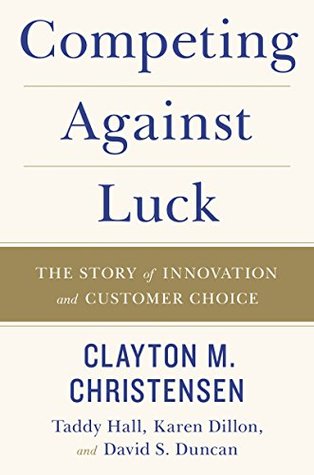More on this book
Community
Kindle Notes & Highlights
the one thing that matters most in innovation—the causality behind why I might purchase a particular solution. Yet few innovators frame their primary challenge around the discovery of a cause.
“If you do not know how to ask the right question, you discover nothing.”
focuses on deeply understanding your customers’ struggle for progress and then creating the right solution and attendant set of experiences to ensure you solve your customers’ jobs well,
I wonder what job arises in people’s lives that causes them to come to this restaurant to “hire” a milk shake?
What causes us to buy products and services is the stuff that happens to us all day, every day.
the customers themselves had a hard time answering that question until we probed on what else they sometimes hired instead of a milk shake.
the early-morning customers all had the same job to do: they had a long and boring ride to work.
It turned out that there were a lot of competitors for this job, but none of them did the job perfectly.
bananas
Doughnuts
Bagels
Snickers bar.
It turns out that the milk shake does the job better
competitors—which,
are not just milk shakes from other chains but bananas, bagels, doughnuts, breakfast bars, sm...
This highlight has been truncated due to consecutive passage length restrictions.
what these milk shake buyers had in common had nothing to do with their individual demographics.
Rather, they all shared a common job they needed to get done in the morning.
In that moment, the milk shake isn’t competing against a banana or a Snickers bar or a doughnut, like the morning milk shake is. It’s competing against stopping at the toy store or my finding time for a game of catch later on.
Same product, different job, which means different competition! Context of job matters to determine competition, customer motivation, product life cycle, etc.
If this fast-food company had only focused on how to make its product “better” in a general way—thicker, sweeter, bigger—it would have been focusing on the wrong unit of analysis.
You have to understand the job the customer is trying to do in a specific circumstance.
one-size-fits-none product that doesn’t do either of the jobs well.
one of the most important principles in innovation—what causes customers to make the choices they do—doesn’t seem to get traction with most organizations.
we believe Jobs Theory provides a powerful way of understanding the causal mechanism of customer behavior,
the definition of what we mean by a job is highly specific and precise.
It’s not an all-purpose catchphrase for something that a customer wants or needs.
After you’ve uncovered and understood the job, you need to translate those insights into a blueprint to guide the development of products and services that customers will love.
This involves creating the right set of experiences that accompany your product or service in solving the job
you have to ensure that you have integrated your company’s internal capabilities and processes ...
This highlight has been truncated due to consecutive passage length restrictions.
Creating the right experiences and then integrating around them to solve a job, is critical...
This highlight has been truncated due to consecutive passage length restrictions.
That’s because while it may be easy for competitors to copy products, it’s difficult for them to copy experiences that are well integrated into your company’s processes.
How to create those experiences? Definition of experience here? Requires first understanding the job to be done and customer experience cycle (identify the job, identify potential products to hire, make a decision, hire a product, use and evaluate product for the job)
Jobs Theory explains why customers pull certain products and services into their lives: they do this to resolve highly important, unsatisfied jobs that arise.
frames competition in a way that allows for real differentiation and long-term competitive advantage,
articulate their company’s purpose with greater precision.
A job is
defined as the progress that a customer desires to make in a particular circumstance.
Fully understanding a customer’s job requires understanding the progress a customer is trying to mak...
This highlight has been truncated due to consecutive passage length restrictions.
This provides critical information for how to innovate to make your solution more attractive than any competitor’s.
for the people buying FranklinCovey products, their single biggest challenge was getting line leaders and other influencers within the company to recognize what they did in learning and development was mission critical.
competitive advantage is built not just by understanding customers’ jobs, but by creating the experiences that customers seek both in purchasing and using the product or service—and then, crucially, building internal processes to ensure that those experiences are reliably delivered to the customer every time.
many innovations that are launched with great hope and fanfare flop because they have focused on improving the product on dimensions that are irrelevant to the consumer’s actual Job to Be Done,
A product that has been designed specifically to fulfill a well-understood Job to Be Done
says to the customer, “We get you.”
Organizations that lack clarity on what the real jobs their customers hire them to do can fall into the trap of providing one-size-fits-all solutions that ultimately satisfy no one.
bringing into focus distinct “jobs-based” segments—including
Seeing your customers through a jobs lens highlights the real competition you face,
If you can spot barriers to progress or frustrating experiences, you’ve found the first clues that an innovation opportunity is at hand.


